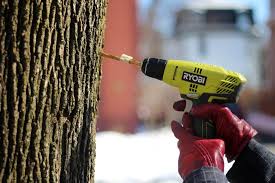
Liquid Gold. Tapping Into Nature: Drilling into Trees for Maple Syrup
By Constantine Papageorgiou
As winter begins to fade and the first signs of spring emerge, many people eagerly anticipate one of nature’s sweetest gifts: maple syrup. But have you ever wondered how this delicious treat makes its way from tree to table? The process starts with tapping sugar maple trees, and it all begins with a simple drill.
Tapping is the method used to collect sap from sugar maples during the sugaring season, which typically occurs in late winter or early spring when temperatures fluctuate between freezing at night and warming up during the day. This temperature change creates pressure within the tree that allows sap to flow.
Before drilling into any tree, it's essential to choose a healthy mature sugar maple — preferably one that's at least 10-12 inches in diameter. Younger trees need time to grow strong; tapping them too soon can hinder their development. A good rule of thumb is only to tap about one hole per foot of trunk diameter. To get started on your tapping adventure, you'll need a drill, a spout or tap, a bucket for collection and a measuring tape to help you assess tree size. Make sure your tools are clean before use! Cleanliness helps prevent introducing bacteria that could harm the tree.
When you are ready to drill, choose a spot ideally on the south-facing side of the tree where sunlight hits most directly. This area will warm up quicker and encourage better sap flow.
Drill at a slight upward angle (about 15 degrees) so gravity assists in directing sap toward your spout once inserted. In terms of depth, aim for about 1½–2 inches deep but avoid going too far as this can damage internal tissues vital for nutrient transport. Make sure to remove wood shavings from around your drilled hole — they can harbor bacteria if left behind.
When it’s time to insert the spout, gently hammer in your spout until it fits snugly against the bark without causing excessive damage — this should create an airtight seal allowing maximum sap collection. Whether using buckets suspended below each tap or tubing systems leading straight back to storage containers — you’re now ready for Mother Nature's sweet reward.
Once tapped, check daily for sap accumulation — ideally, every morning before temperatures rise significantly since warmer days lead to more liquid flowing through those veins. Depending on weather conditions and tree health, you may find anywhere from a few drops of sap up to multiple gallons — enough to start the transformation into delicious maple syrup.
Drilling into a tree might seem daunting initially — but with proper techniques and respect towards nature — it becomes an incredibly fulfilling journey filled with eager anticipation.
